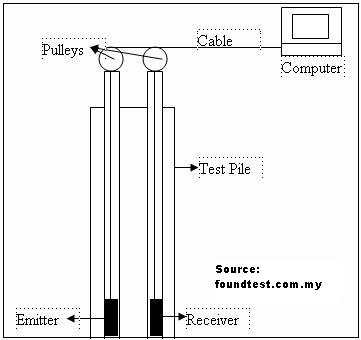The Sonic Logging
Technique, also known as Cross Hole
Ultrasonic Method (CHUM) is used to determine the defect in cast
in-situ piles, caisson, barrettes and diaphragm walls. Such tests
can produce an economic survey of each pile to complement the more
expensive capacity testing which is restricted to a small percentage
of piles.
The homogeneity of
a foundation pile is very important in order to ensure its
serviceability to support the load transferred from the building or
structure constructed. Phenomena such as honeycombing due to
inadequate vibration, segregation due to over vibration and improper
concrete placement method, wash out of cement, cracks in the pile
shaft, inclusion, necking and arching of the pile due to collapse of
side walls during withdrawal of the temporary liners are very common
in construction of bore piles. Therefore, effort must be taken to
ensure each pile installed on site to be free from any kind of
defects during the installation.
The Sonic Logging Test can be the most
suitable method to detect the defects of the piles that are
mentioned above. In homogeneous concrete, free from defect and
variation in quality, the velocity of "sonic" wave propagation is
constant. The sonic logging technique works by way of detecting any
acoustical irregularities on the sonic profiles between the access
tubes. For example, a sudden increase of the travel time at any
depth indicates a defect at this depth or a relatively low quality
concrete has being localized. The cross hole ultrasonic method has
been described in a number of recognized standards (AFNOR 1993, ASTM
2002). As we shall see later, the cross-hole method may be further
refined to produce high-quality results
The sonic method belongs
to the external test-methods, as it accesses only the top of the
pile. Two probes are lowered inside two of the tubes. One of these
probes is an emitter and the other a receiver of ultrasonic pulses.
Having been lowered to
the bottom, the probes are pulled simultaneously upwards to produce
an ultrasonic logging profile. The transmitter produces a continuous
series of waves in all directions. Some of these waves do eventually
reach the receiver.
The testing instrument
then plots the travel time between the tubes versus the depth. As
long as this time is fairly constant, it shows that there is no
change in concrete quality. However, a sudden increase of the travel
time at any depth indicates a defect at this depth. The cross hole
method has been described in a number of recognized standards (AFNOR
1993, ASTM 2002 ).

For more information, quotation or site
appointment, please call us or drop
us a message here.
Our existing clients may
download a complete Method
Statement / Technical Specification of Sonic Logging Test (SLT)
here.